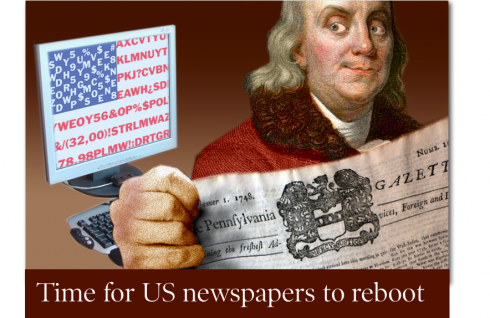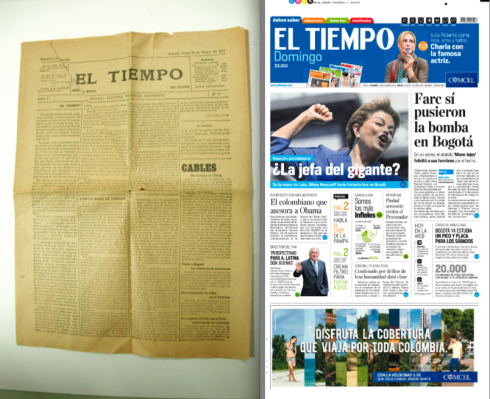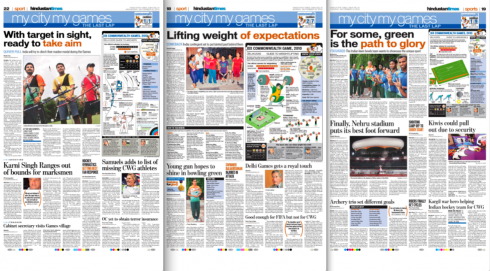Update #2, Wednesday, Oct. 6, Bogotá, 05:03
TAKEAWAY: So our major changes at Colombia’s El Tiempo spread beyond the borders of the country—-where street sales are up 27% Sunday, 42% Monday—- and into the corner of newsrooms around the world, especially American newsrooms, where dozens of editors/designers write asking one single question: why can’t the US newspapers innovate anymore?

Illustration by the late Miguel de Lorenzi/former art director La Voz del Interior/Argentina
In 2008, I wrote a blog post about the state of US newspapers and their lack of ability to make some changes so necessary to their continuous existence.
I am returning to read that same post now, in 2010, as I receive an avalanche of emails from US editors and designers, following the successful launch of El Tiempo’s new and revolutionary concept, all asking the same question:
Why can’t the US newspapers do something like this?

Early results show increase in street sales nationally for El Tiempo
I wish I had the answer. Does anyone? If so, I invite you to chime in and leave your comments here. But I do have an idea of why this is so, even though it is not through firsthand experience. I rarely visit the newsroom of an American newspaper anymore, and have not done so for years, with the possible exception of
my occasional visits to The Philadelphia Inquirer and Philadelphia Daily News where we have done some work leading to some minor changes in the Daily News so far.
At the core of the lack of change is what I would describe as a malaise, a self defeating attitude that the printed product they produce daily has its days counted. I talk to US editors and designers who lament more than create.
If one were to aggregate all the time that is spent “whining” on how bad things are, and how disastrous the future horizon looks, it would amount to hours that could best utilized “nurturing” the printed product, and leading it to the changes that are necessary to reboot it and to give it a presence and a reason to exist.
Age has nothing to do with it!
It is all about attitude, I think, and it has nothing to do with the age of the editors or designers involved. Some “youngsters” whine and are as negative about the future of print as their older colleagues.
Digital platforms are a reality, not likely to disappear, and most likely to thrive and to provide revenue for media houses worldwide, in due time. Digital is the future, but digital first-—-a song that is choreographed and sung in so many newsrooms by executives of a certain age who wish to impress their peers with the “with it” attitude—-is NOT the answer at all.
Storytelling first is more likely. Platforms second.
In every single one of my projects, I assemble a team of creative people to help us hit the reset button. ONE indispensable person in that group is what I call the “print edition chaperone”. Yes, chaperones protect and keep someone from getting into trouble and mischief. In the case of newspapers, the print edition chaperone keeps the printed product—-which has the brand and provides the mother’s milk of content for all other platforms—-from being sidelined, ignored and put to a slow death.
A modern media company nurtures print while advancing digital platforms.
In the next 20 years we will have this quartet of platforms coexisting. Yes, the role of print is not what it was 10 years ago, but I also don’t wear the suits and ties that I wore ten years ago, thank you.
I have maintained for years that no medium kills another medium. Print will not die in those places where the nurturing, reinventing and redefining of its purpose is taken seriously.
This is what El Tiempo has done so well. Here it is, a dean of Latin American dailies, the most respected and authoritative newspaper of Colombia, El Tiempo dares to take a deep look inside. Not a thought ever of sidelining it. In fact, all thoughts were of giving it enough power to go another 100 years.
But to do that, change had to be emphasized and taken seriously. The management, the editors, designers, advertising department, all had to go through a rigorous process of adapting to something new, to abandon old ways of doing things, and to assimilate what the new audiences are all about and how they process information. Not easy, but neither is training for and running a marathon, or maintaining good relationships, or balancing your checkbook.
Change does not come easy not at El Tiempo, not anywhere: some editors were worried about their sections and territories invaded; the advertising department worried about positioning of ads and the question of revenue.
We all sat at the same table to discuss it together, leading to the El Tiempo that appeared Oct. 3 and that has been, by all measures, an incredible success with readers and advertisers. (Street sales were up 27% Sunday, 42% Monday of this week)
But El Tiempo‘s rethinking has done more than that, based on the dozens of mails I have received from across six continents.
It has provided so many in our business with a sense of optimism, pride, and momentum for print. It is as if a huge piñata had rained newsprint confetti of hope and optimism from the skies of Colombia all the way to corners of New Zealand and Australia, or Topeka and Hong Kong. The mails I am getting from colleagues worldwide sound like it is Christmas, New Years and the Fourth of July, all in one glorious day.
It’s all about passion, isn’t it?
“Wow, such passion poured into a printed newspaper in 2010, I can’t get over,” wrote one journalist from France.
“I cannot imagine my newspaper here in the US ever doing something so daring, yet we need it so badly, why is that not happening here,” wrote a copy editor from the US midwest.
“Here in the States, I think you have such a nervous nelly atmosphere relating to anything advertising – “OH NO we cannot give up five section front positions, and back pages, in exchange for three, that will never fly with our advertisers and we cannot risk losing 5% of that revenue!!!,” writes a major US metropolitan daily designer.
”“Fear to take real risks has also stunted newspaper innovation (some of this motivated by dollars, other times by J-School sacred cows and conventions). I know you have battled this for a while in U.S. newsrooms, the first response is usually: “OH NO, we can’t do that!” Or, “Our readers would not like that.” I always find it puzzling how editors are the first to speak for their readers, even before asking them what they think or feel,” writes Kelly Frankeny, a New York City-based creative director with Garcia Media, who has served as art director at the San Francisco Examiner.
And the major of a major national US newspaper writes me: “Often in the U.S. it looks the patient has put itself on the do-not-rescusitate list.”
On the issue of formats
Kelly, who has joined me on a variety of projects worldwide, reminds me of how we have suggested conversion to compact formats to a number of US clients, with no takers.
“Mario—how many innovative ideas have you given U.S. newspapers that actually even made it to a focus group? I personally have seen many of those ideas shelved before they even had a chance to flourish, much less be tested by users.
“Take, for example, compacts. Most readers love them. How many U.S. newspapers ever took the time to do develop a serious product in a smaller size because the reader wanted it? Most of the smaller formats were done to save money on newsprint, not to develop something that would make the reader connect better with the product. Most editors personally feared being perceived as a “sensational” or less-serious, as opposed to genuinely considering what readers might want to use. This is antiquated thinking in a rapidly changing media world. I don’t think readers would really care if the paper was smaller if it provided the information they were looking for in a more user-friendly format,” she says.
Finally, Kelly compares newspapers to Apple: “What if Apple took the same approach to their products? Only developed components that saved them money as opposed to products that made people’s life easier and more enjoyable. They would be out of business! No wonder most young readers do not connect with most printed products today. Many look and read for the most part, they way they did 40 years ago.”
The creative people are there
It is true that we have vibrant and creative people across the landscape of US newspapers, who are having to do with much less.
In fact, it is good to point out that in many midsize dailies the whole concept of middle management has been wiped out. And it hurts, as you have a vacuum of the kind of leadership that can lead to change, through small group discussions away from the top management. Let the discussions start at the grassroots level, then present the grand ideas to top management. With the elimination of middle management in so many US dailies, this is not possible to achieve, or not as easily.
An overworked staff is not likely to be playing in the sandbox of new ideas, not when deadlines are piling up and tomorrow’s newspaper must be finished.
But, enough of my own whining.
I believe that creativity and impetus to achieve have nothing to do with staffing and more to do with how one feels about his work—-some call it passion.
Passion can lift an Airbus 380 off the ground and make it fly.
People sitting around celebrating storytelling and the many platforms we now have can make things happen, as was the case at El Tiempo.
It is all about the little victories, and I can testify to that.
In no way do I wish to give the impression here that there is NO innovation taking place in US newsrooms.
But it is probably happening in small pockets, in isolated moments here and there, and perhaps without that much needed nurturing from top management—-which may have other worries with which to cope.
I know that there are many good things happening right there in the heartland of America, in some small newsroom, where the staff is overworked and tired, but where flickers of passion burn brightly.
I know that there are “print chaperones” who do the job without the title. It comes naturally.
I know that somewhere, someone is celebrating that good headline, the great photo with impact, the wonderful page design that enhances the story.
I know that passion comes to work with a majority of the people who work in our newspapers.
I also know that all it takes is one recalcitrant, negative editor or publisher to spoil the party. Unfortunately, there are more of those in charge than the industry can afford at this crucial moment.
All that is rich about American newspapers
American newspapers have offered so much that is good to the world, and I am sure they can do it again.
We have shown the world what solid, objective reporting is all about; we have pioneered in the concept of the in-depth report (remember Watergate); we have been the model for the emergence of visual journalism as a major force in the storytelling process. Most importantly, NOBODY does photo journalism like the American newspapers do, even today; our photojournalists are that, men and women trained in journalism schools, for the most part, who bring to their craft all that is good and worth knowing about the reporting of the story.
The way American newspapers display photography is still the envy of the world.
We can still do it. We can still pick ourselves up, as El Tiempo has done in Colombia, regroup and reorganize: tear down walls that no longer should exist, clear the newsroom out of the ineptly negative influences, and restore the sense of passion and professionalism that print needs so desperately.
Time to get the print chaperone in place, to stamp out negativity from any conversation in the newsroom, move the sandbox right and center, celebrate the craft of storytelling in its many variations.
A friend recently wrote me: “The American newspaper is not quite dead…..it’s just comatose”.
This is a good time to snap out of the coma, to bring out that colorful piñata and hit it with the biggest stick of passion we can find.

The following items reflect people and papers that are moving forward, celebrating and not lamenting the fate of the printed newspaper.
*Charles Apple’s blog which showcases some good individual page designs, a pure and visual celebration of what can happen with people with ideas allow them to land on the page, with the reader rejoicing. Charles also celebrates the good people who are doing good work at newspapers, from the very homey mentioning of their birthdays to discussing specific projects that they are passionate about .
*Bob Newman’s Facebook feeds, which celebrate great magazine design, past and present—not major reinventions and nothing relating to business models, which I would like to hear more about. Success stories out there? Go here:
http://www.facebook.com/robertnewmandesign
http://www.facebook.com/newmanology
*Ron Reason’s call to action for innovation in print advertising, where he writes about an Atlanta newspaper with new ad modules. And, asks Ron: Is anyone else out there cheerleading about the survival of newspaper advertising? I wonder.
*Joe Zeff’s presentation, “The Economics of the iPad,” is valuable not just for those working on tablet apps, but for everyone looking to rethink their product. Joe’s list of key differentiators is a guide to innovative thinking: “Make it local, current, personalized, convenient, authoritative, exclusive, simple, useful, and fun.”
*The newly redesigned Globe and Mail is the first North American daily to print on glossy stock. It also now features color on every page. With the new design, they say they will feature more magazine-style pieces with big photos, as well as shorter items. More information is available here: http://www.niemanlab.org/2010/10/doubling-down-on-print-canadas-globe-and-mail-unveils-a-new-print-edition-to-complement-the-web/.
As mentioned early, I know that there is innovation and passion out there in the newsrooms of US newspapers, and we need to know where it is. Readers, if you are doing something that we should list here, or know someone who is, please let me know to include in future posts.
Today’s front page: El Tiempo

The front page of El Tiempo for today Wednesday
The way it was

Visiting the past can be interesting. One of our blog readers from Colombia, Fabian Cardenas, sends us this keepsake, a front page of El Tiempo of 1911.
In India: Commonwealth Games 2010 open

Page openers from Hindustantimes (Delhi) on the day of the opening of the games

Inside page treatments standardizing how each sport was covered: the Hindustantimes (Delhi)

Pages from Malayala Manorama, published in Kerala

Pages from The Hindu, one of the national English-language dailies of India
We show you here assorted pages from three of our newspaper clients in India as they covered the start of the Commonwealth Games 2010 in Delhi.
Malayala Manorama, published in Kerala, displays large color images to present the opening night ceremony. Inside pages devote ample space to the Games, which have been marked by controversy the past few weeks for what some participating countries described as “poor preparations” especially in the athletes’ village. But, alas, the games have opened. We will show you more pages of Indian newspapers as we receive them.
The Hindu, one of the premiere English-language dailies in India, is published in Chennai, but has editions throughout most major Indian cities. Here is how the newspaper covered the opening of the Commonwealth Games 2010, with smaller images accompanied by text.